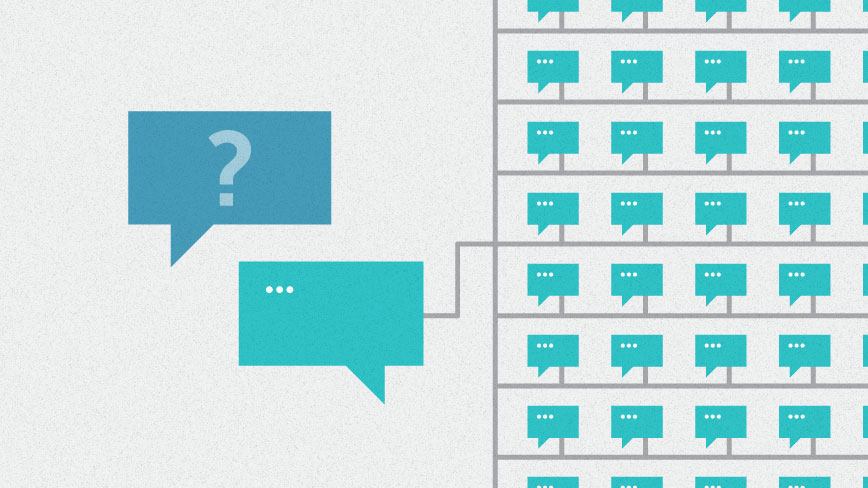More than just entertaining, chatbots can improve customer experience and collect critical marketing data that can enrich predictive analytics and more.
Since the golden age of pulp science fiction, humans have speculated about the logical and ethical challenges of artificial intelligence (AI). Now, chatbot AIs can order a pizza for us. The astounding leap from theory and speculation to performing applied tasks shows just how quickly AI has advanced. It also shows just how quickly it has gone from extraordinary to ordinary, which is good because it means people are actually using products as a tool, not as a novelty. To date, almost 60% of Americans ages 18 to 55 have used a chatbot.
A “chatbot” refers to an AI-powered program that can use keyword association or natural language processing (NLP) to interpret text and respond in a human-like, conversational way. Chatbots can be included in add-on chat widgets for a website or an app, and can also be enabled as a branded account on existing chat services, such as social media messaging applications. The latest version of chatbots has them taking on a life, and voice, of their own, turning AIs into operating systems for intelligent personal assistant products (think Siri, Alexa, Cortana).
Through their many diverse applied uses, chatbots can provide significant value to brands in certain situations. These scenarios typically include using chatbots as AI-powered customer service representatives, but can also span to assist in carrying out everyday tasks – such as delivering tailored news updates, providing local movie show times, sending sports highlights, and even assisting in diagnosing health issues. At the same time, they gather valuable marketing data in the form of archived conversations that could power the advanced marketing AIs of the future.
Chatbots Provide 24/7 Customer Service Support
Whether on an app or website, chatbots can help answer customers’ questions and resolve their problems. This always-on availability solves a critical limitation for companies that don’t have the time or money to field customer issues. Chatbots can provide customer service support in different time zones and languages at a mere fraction of the cost it takes to employ live customer service reps that fulfill the same duties.
Chatbots can also function in a way that provides customer support at scale. Instead of customers navigating a website to find specific information or a FAQs page, a chatbot rep could answer these questions and much more within a few strokes of the keyboard. They can not only handle complaint tickets, but can also be used to automate responses and certain functions on websites, which can prevent customers from getting frustrated and abandoning a site.
For example, chatbots could handle simple tasks like scheduling a home repair appointment in 30 seconds via chat. In this way, some companies are able to reassess their need for large teams of 24-hour customer service reps and reallocate resources and budgets to more valuable efforts.
Chatbots Provide Services in Messaging Apps
With consumers spending 85% of their time on just five apps, it seems the possible consumer touchpoints are limited. So, instead of requiring a user to download a new app, many brands are now leveraging existing messenger applications as a means to engage directly with their audiences at scale. These messaging services have turned into test beds for branded chatbots that provide services ranging from the practical to the entertaining.
While some brands use messenger apps as an extension of their web-based customer service bots, others find more innovative ways to interact with their audiences. For instance, Disney created Judy Hopps Facebook Messenger Bot to accompany the release of their movie Zootopia. The bot not only leveraged NLP capabilities to ensure it could respond to the broad potential of user input, but also layered in authenticity by incorporating Judy’s personality and relationship management. While users were engaged in one-on-one conversations with Judy to help solve mysteries based on details from the film, the bot stored and recognized user information to personalize its future interactions, driving repeat engagements and social sharing.
Chatbots Supply Crucial Marketing Data
Be it via the web or in a messaging app, interactions with chatbots automatically capture every conversation between a customer and the company’s AI. Rather than just measure metrics, bots can store the language a customer uses to understand brand sentiment, learn how real people ask questions, and determine what drives – or deters – customer engagement. Over time, revelations from this data can help companies train both their AI and human customer service reps to provide the smoothest and most pleasant path to a resolution or purchase.
Additionally, chatbots can help optimize automated database usage, creating a customer touchpoint where people ask questions and AIs can query mass volumes of data at once to produce a tailored answer. Chatbots should not only be able to recall customer conversations of the past, but access other datasets, using machine learning to better each interaction and personalize future responses. For instance, if someone asks a chatbot for a product recommendation, AI can query both the customer’s browsing data and product listings to make a personalized suggestion. The customer can accept or reject the suggestion immediately, creating one more data point that drives improvements in not just chatbot functionality, but also in data-backed marketing activities such as predictive analytics.
In this way, the seemingly simple or insignificant conversations we have with chatbots can now power more meaningful AI interactions of our future. But even as chatbots become more sophisticated – hopefully, they still won’t be above ordering a pizza.

